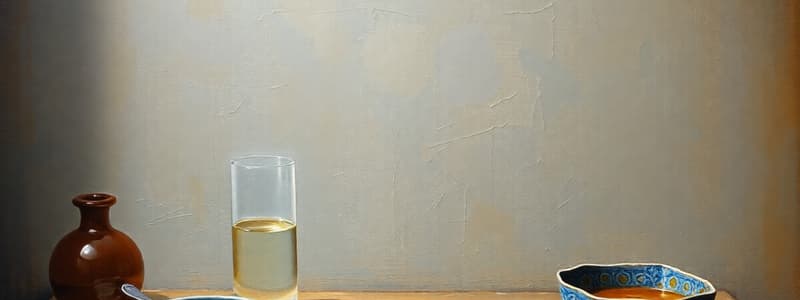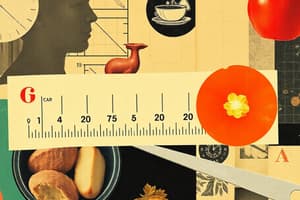Podcast
Questions and Answers
What is the main aim of the material for the MATATAG K to 10 Curriculum?
What is the main aim of the material for the MATATAG K to 10 Curriculum?
- To replace traditional teaching materials
- To assist in delivering curriculum content and lesson competencies (correct)
- To develop new teaching methods for educators
- To provide an overview of the education system
What is the primary goal of asking students to analyze the photos on Day 1?
What is the primary goal of asking students to analyze the photos on Day 1?
- To discuss the nutritional value of different cooking methods.
- To review and identify various cooking techniques. (correct)
- To compare the efficiency of different cooking methods.
- To create a culinary recipe based on the photos.
Which individual's contribution to the development team is cited in the document?
Which individual's contribution to the development team is cited in the document?
- The management team at Philippine Normal University
- The Director of the Bureau of Learning Resources
- Eddilyn A. Buniel-Plaza, PhD (correct)
- Victor S. Rosales, PhD
Which cooking method is not mentioned in the lesson's picture identification?
Which cooking method is not mentioned in the lesson's picture identification?
What is one of the standards outlined in the curriculum content?
What is one of the standards outlined in the curriculum content?
What is the expected outcome for students after identifying the cooking methods from the pictures?
What is the expected outcome for students after identifying the cooking methods from the pictures?
What performance standard are learners expected to meet?
What performance standard are learners expected to meet?
Which method of cooking likely promotes the most moisture retention?
Which method of cooking likely promotes the most moisture retention?
What type of actions may result from unauthorized reproduction of the material?
What type of actions may result from unauthorized reproduction of the material?
What could be a possible reason for analyzing cooking method photos in the classroom?
What could be a possible reason for analyzing cooking method photos in the classroom?
Flashcards
Hospitality and Tourism Industry
Hospitality and Tourism Industry
The hospitality and tourism industry encompasses the businesses that provide services related to travel, accommodation, food, and entertainment.
Food Preparation
Food Preparation
The process of preparing food involves selecting ingredients, measuring quantities, using specific cooking techniques, and ensuring food safety.
Food Service
Food Service
Food service involves receiving orders, preparing meals, serving dishes, and providing customer service.
Safety Precautions
Safety Precautions
Signup and view all the flashcards
Matatag K to 10 Curriculum
Matatag K to 10 Curriculum
Signup and view all the flashcards
Activating Prior Knowledge
Activating Prior Knowledge
Signup and view all the flashcards
Short Review
Short Review
Signup and view all the flashcards
Identification
Identification
Signup and view all the flashcards
Direction
Direction
Signup and view all the flashcards
Analyze the Photos
Analyze the Photos
Signup and view all the flashcards
Study Notes
TLE Grade 7, Quarter 3, Lesson 8
- Lesson Focus: Food material measurement conversion
- Learning Competency: Demonstrate an understanding of the conversion of units in measurement for food materials
- Lesson Objectives:
- Identify units of measurement for food materials
- Differentiate various food material measuring techniques
- Demonstrate appropriate measurement of dry and liquid ingredients
- Show basic calculation and conversion skills using English and Metric systems
- Value the significance of measuring food materials
- Content:
- Kitchen Math: English and Metric System
- SDG Alignment: SDG 4 (Quality Education), SDG 12 (Responsible Consumption and Production)
- Learning Resources:
- Various cooking techniques and tips, resources on metric conversions, learning modules on commercial cooking, measuring techniques in food selection and preparation
- Teaching and Learning Procedure (Day 1):
- Knowledge Activation: Review previous lessons
- Identification: Students identify cooking methods from images
- Teaching and Learning Procedure (Day 2):
- Unpacking Content Vocabulary: Define calculation, conversion, dry ingredients, English System, food materials, kitchen mathematics
- Teaching and Learning Procedure (Day 3 & 4):
- Measuring techniques: Demonstrate how to measure dry and liquid ingredients accurately
- Activities:
- Measuring dry ingredients (brown sugar, white sugar, flour, baking soda, milk powder)
- Measuring liquid ingredients (cooking oil, concentrated milk, water, soy sauce, melted butter)
- Assessment: Students demonstrate measuring skills
Vocabulary
- Calculation: Performing mathematical operations to determine a result.
- Conversion: Changing from one form or state to another.
- Dry Ingredients: Food items that are typically solid; non-liquid components used in cooking and baking.
- English System: Commonly used units of measurement in some countries.
- Food Materials: Unprocessed ingredients used in food preparation.
- Kitchen Mathematics: Applying mathematical principles in cooking and food preparation.
- Metric System: International measurement system based on powers of ten.
- Unit of Measurement: Standardized quantity to express physical attributes.
Measuring Methods & Equivalents
- Various measuring tools and techniques explained (spoon, cups, digital scales)
- Conversion charts provided between English and Metric units (volume and weight) for common ingredients
- Example conversion equivalents are listed (e.g., 1 tablespoon = 15ml, 1/4 cup = 60ml, 1 ounce = 28g, 1 pound = 450g)
- Emphasize accuracy in measuring
- Methods for various ingredients (liquid, dry, solid).
Additional Notes
- Learning Materials: Indicate specific materials used during activities.
- Teacher's Role & Practices: Explain the teacher's role in conducting activities and showcasing effective practices.
Studying That Suits You
Use AI to generate personalized quizzes and flashcards to suit your learning preferences.




